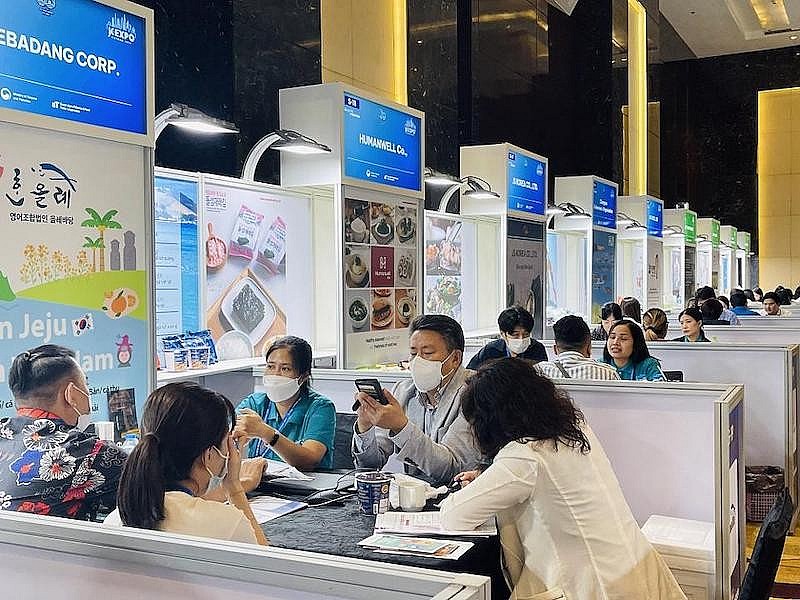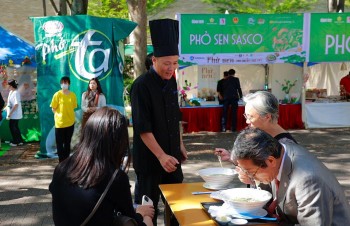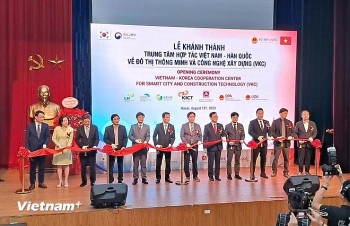30 Years of Vietnam - RoK Trade Relations and Prospects for Bilateral Turnover
30 Years of Vietnam - RoK Trade Relations: Reflecting the Outstanding Achievements
| Vietnamese Pho Festival Takes Place in Seoul | |
| Humanitarian Cooperation Connects the Peoples of Vietnam and Republic of Korea |
From 1993 to 2008
From 1993 to 2008, Vietnam-RoK trade relations experienced notable achievements and characteristics.
First, the bilateral trade turnover between the two nations has seen a robust and continuous surge, multiplying over 15 times from 581 million USD in 1993 to over 8.85 billion USD in 2008, with an average annual growth rate of 21.3%. Notably, the growth rates in 1994-1995 and 2007-2008 were significantly higher, at 40.3%, 84.1%, 38.5%, and 34.4%, respectively. This surge can be attributed to the substantial increase in foreign direct investment (FDI) from RoK to Vietnam during 1993-1996 and 2002-2006, which led to heightened imports of machinery, equipment, and other inputs for the invested facilities.
Second, although the average annual growth rate of exports exceeds that of imports (27.9% versus 20.7%), Vietnam consistently experiences a trade deficit with RoK. This deficit has been steadily rising, from 382.4 million USD in 1993 to 5.28 billion USD in 2008.
Third, Vietnam's standing in the RoK's market, as well as RoK's in the Vietnamese market, has seen considerable improvement. In export terms, RoK consistently ranks among Vietnam's top ten export destinations, whereas Vietnam was positioned 27th to 30th among more than 200 countries and territories exporting to RoK in 2008. On the import side, RoK remains one of Vietnam's five largest sources of imports, with Vietnam ranking 11th to 13th in 2008 among RoK's import markets.
Fourth, Vietnam's exports to RoK have seen a positive shift towards a decrease in raw materials and an increase in manufactured goods. This change is partly due to Vietnam's policy promoting the processing and manufacturing industries, which boosts the production and export value of manufactured goods. The demand for these goods, particularly in electronics, machinery, and equipment, is high in RoK. On the other hand, Vietnam's imports from RoK have remained stable, with manufactured goods making up 70% to 80% of the import turnover. These imports primarily support Vietnam's industrial production and are inputs for Korean companies with investments in Vietnam, highlighting the disparities in economic development and technological levels between the two nations.
Fifth, the policy environment has improved significantly. For Vietnam, it is necessary to continue to improve trade policy toward facilitation enhancement - upgrading the customs system, and increasing the application of international standards. For RoK, it is necessary to continue to apply incentives to attract investment and invest abroad, thereby boosting the ability to improve technology levels and explore more effective foreign investment markets. The increase in RoK investment in Vietnam resulted in a rise in Vietnamese imports from RoK.
 |
| K-Expo Vietnam 2022 was held on October 18 at the Hanoi-based JW Marriott Hotel to facilitate trade connections for South Korean and Vietnamese firms. (Photo: HanoiTimes) |
From 2009 to 2022
In October 2009, the visit of the President of the Republic of Korea, Lee Myung-Bak, to Vietnam marked the announcement of an upgrade in bilateral relations to a "Strategic Cooperative Partnership". The leaders of both countries expressed high regard for their achievements and committed to increasing bilateral trade turnover to 20 billion USD by 2015, with efforts to balance trade. Over the decade following the establishment of the Strategic Cooperative Partnership, from 2009 to 2022, the two nations have realized goals and accomplishments that surpassed initial expectations. Specifically:
First, the bilateral trade turnover between Vietnam and the Republic of Korea has seen robust growth, increasing nearly tenfold from 9.03 billion USD in 2009 to 86.4 billion USD in 2022, with an average annual growth rate of 18.6%. In 2015, the trade turnover between the two nations reached 36.49 billion USD, exceeding the early expectations of 20 billion USD set when they established a strategic cooperative partnership in 2009. Following eight years of the Vietnam - RoK Free Trade Agreement (VKFTA), the trade volume more than doubled from 36.49 billion USD in 2015 to 86.4 billion USD in 2022, marking a significant increase in the absolute value of trade turnover between the two countries.
Second, the relationship between the two countries has consistently been that of significant trade partners, showing growth over time. In 2009, the total trade turnover between Vietnam and RoK represented 7.11% of Vietnam's total trade turnover, which increased to 14.37% by 2017. Although there has been a slight decline from 2018 to the present, the figures have consistently ranged from nearly 12% to 14%. For RoK, the trade turnover with Vietnam has steadily risen from 1.13% in 2009 to 5.35% in 2022. As of 2022, RoK ranks as Vietnam's third-largest trading partner, following China and the US, the third-largest export market after the US and China, and the second-largest import market after China. Concurrently, Vietnam has overtaken Japan to become RoK's third-largest trading partner, trailing only China and the US.
Third, the trade deficit between Vietnam and RoK has decreased from 70% (54.4% of the total import-export turnover) in 2009 to 56% (43.8% of the total import-export turnover) in 2022, mainly due to imports of machinery and equipment for production in the FDI sector. However, the absolute value of the trade deficit has increased from USD 4.9 billion in 2009 to USD 37.8 billion in 2022. Despite the 2022 trade deficit of USD 37.8 billion, Vietnam has become RoK's largest trade surplus partner for the first time.
Fourth, the trade structure between the two nations is largely complementary, with minimal direct competition. Vietnam's exports are primarily products of South Korean FDI enterprises (such as phones and components, computers, electronic products and components, machinery, and equipment) and items that are Vietnam's strong suits, including agricultural and aquatic products, processed foods, textiles, footwear, and wooden products. Conversely, Vietnam's imports from RoK consist of goods that serve as inputs for FDI enterprises and industrial raw materials and fuels, including computers, electronic products, and components, various types of phones and components, machinery, equipment, tools, spare parts, all kinds of gasoline, raw plastics, all types of fabrics, other base metals, components, auto parts, plastic products, and all kinds of iron and steel. In the early 2010s, crude oil, textiles, and seafood were the leading export commodities, making up about one-third of the total export turnover. Since 2015, following the establishment of a strategic partnership, Vietnam has significantly shifted its export focus towards more processed and assembled goods with a higher technological content. Products manufactured by South Korean FDI enterprises, such as various phones and components, computers, electronic products and components, machinery, equipment, tools, and spare parts, have risen to the top of the export value list, followed by textiles, seafood, etc. Since 2016, phones and components have been the most significant export items to RoK, with 2016 exports amounting to 2,748 million USD, according to the General Statistics Office in 2017.
The shift in Vietnam's export structure and the rapid expansion of the phone and components sector can be attributed to the country's strategy to boost the export of industrial goods, processing, and assembly. This was coupled with increased investment from South Korean companies; notably, in 2015, Samsung augmented its investment by 3 billion USD for a factory in Vietnam and relocated its mobile device screen production line from RoK to Vietnam. Concurrently, LG commenced operations at its Hai Phong factory, capitalized at 1.5 billion USD, to manufacture electronic products and components, including phones. LG's production at this facility was estimated at approximately 10 million units in 2015. LG captured a significant market share in the RoK's phone industry, averaging over 20%, which is half of Samsung's, indicating a robust demand for LG phones (General Statistics Office, 2016).
Fifthly, the Joint Statement on Strategic Partnership saw RoK expressing high regard for Vietnam's efforts in developing a market economy mechanism, acknowledging Vietnam as a market economy following its reform and opening-up policy. Subsequently, upon establishing a Strategic Cooperation Partnership, Vietnam and RoK signed the VKFTA, enhancing bilateral trade with favorable conditions for export enterprises. This FTA, the first of its kind between Vietnam and its economic partners, is comprehensive, highly committed, and ensures balanced interests for both nations. Such policies are crucial foundations for the development of trade between the two countries.
Sixth, RoK has risen to the top and continuously maintained its position as the largest foreign investor in Vietnam. As of May 20, 2023, the country is the largest foreign investor in Vietnam with a total registered investment capital of 81.56 billion USD and 9,666 valid projects. RoK's investors are present in most localities, with the highest concentration in Bac Ninh, Hanoi, Dong Nai, Hai Phong, Thai Nguyen, and Ho Chi Minh City. They are mainly interested in manufacturing and processing industries.
There are many reasons for the miraculous growth in Vietnam-RoK trade turnover, including the following basic reasons:
(i) Vietnam and RoK officially established diplomatic relations in 1992. Together with that, they found in each other opportunities and conditions for economic development of each country. Vietnam identified RoK as a nation with advanced industry, seeking partners for technology export and investment in export-driven production. Meanwhile, RoK saw in Vietnam a nation with an open-door policy, deeply integrated into the global economy, part of the dynamic and promising ASEAN region, and keen to attract foreign direct investment for national development.
(ii) In 2009, Vietnam and the Republic of Korea elevated their diplomatic ties to a Strategic Partnership, centering on several objectives with economic collaboration as a pivotal element. The joint statement outlined commitments to enhance bilateral trade and strive for trade equilibrium; to better the investment climate and support the sustained business ventures of Korean companies in Vietnam, along with advocating for broader investment domains; and to bolster cooperation and reciprocal backing in sectors such as science and technology, workforce development, employment, environmental policies, rural advancement, and energy security. The establishment and enhancement of the Strategic Partnership laid the groundwork for Korea to broaden its investments and foster economic ties with Vietnam. Notably, within the framework of the Strategic Partnership, both nations consented to boost Official Development Assistance (ODA). Vietnam vowed to evolve its market economy through reforms and open policies, ameliorating the investment milieu and smoothing the path for Korean firms to make enduring investments. Korea pledged to motivate its businesses to invest in Vietnam and suggested widening the scope of investment and exploitation, offering more prospects for growth, especially in mining, mineral processing, and infrastructure. The objectives set forth by both countries have been largely achieved, with many surpassing expectations. RoK has consistently been the top foreign direct investor in Vietnam, solidifying its role as a key economic and trade partner.
(iii) Vietnam and the Republic of Korea have ratified the VKFTA, which primarily addresses trade in goods and services, including appendices on telecommunications, financial services, and the movement of natural persons, as well as investment, intellectual property, food safety, and phytosanitary measures (SPS), rules of origin, customs facilitation, trade defense, technical trade barriers (TBT), e-commerce, competition, and cooperation in economic, institutional, and legal areas. The VKFTA has opened up numerous opportunities for Vietnamese exports due to RoK's significant mark-opening commitments and has drawn substantial Korean investment into Vietnam. Both nations have effectively utilized the VKFTA's provisions, significantly enhancing their bilateral investment and trade relations.
 | Vietnam Pho Festival To Enhance Promotion of Vietnamese Culinary Quintessence in The RoK During the 2 days of the Vietnam Pho Festival, foreign friends will also be able to experience the exhibition and folk games, thereby helping them ... |
 | Vietnam, RoK Launch Smart City Center in Hanoi The mission of the Vietnam-Korea Cooperation Center on Smart Cities and Construction Technology (VKC) is to promote research and training on smart cities and advanced ... |
